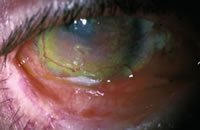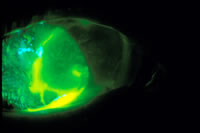Working in an academic medical center, my patient care responsibilites are divided between cosmetic contact lens patients, clinical research patients and patients that require contact lenses out of medical necessity. Of the therapuetic contact lens patients I see, the most difficult group are those patients with ocular surface disease who are resistant to treatment with medications and surgery. Frequently, my corneal surgeon colleagues turn to me for help with bandage contact lenses. It is in this arena that we have found silicone hydrogel lenses to be extremely useful in treating some of the most difficult eyes.
 |
 |
| Epider Bullosa - click to enlarge |
Therapeutic lenses have many applications with regard to corneal rehabilitation. They are most frequently employed as a mechanical barrier, providing corneal protection from the lids, lashes and scar tissue. This enhances corneal surface healing with conditions such as basement membrane disease with recurrent erosions, or non-healing ulcers and epithelial defects. As of May 2003, the Focus Night & Day lens is the only silicone hydrogel to be approved by the FDA for therapeutic use in the United States. This silicone hydrogel lens is approved for protection of the corneal surface and relief of pain in acute or chronic ocular pathology or post-surgical lens use, and is available in Plano for these purposes.
This case report describes the experiences of a 69-year-old female with epidermolysis bullosa simplex who has had long and chronic suffering from secondary ocular surface disease. In the course of her complicated management, silicone hydrogel lenses displayed the best and sometimes the only option for ocular surface healing. Epidermolysis bullosa is a group of inherited disorders in which blistering of the skin develops in response to minor trauma. The severity can range from minor blistering to a lethal form in which constant massive blistering and scarring ultimately lead to death. The skin can be so fragile that even minor rubbing may cause blistering. Blisters are not always confined to just the outer skin. They may develop internally, in such places as the linings of the mouth, esophagus, stomach, intestines and other mucous membranes. Some patients develop ocular inflammation. Secondary ocular complications include chronic blepharitis, bullous lesions of the conjunctivae, corneal ulcerations, corneal scarring, obliteration of tear ducts, cicatricial conjunctivitis, cicatricial ectropion and exposure keratitis.
This patient has had a long history of ocular surface disease secondary to epidermolysis bullosa simplex. She has had multiple surgeries, including a superficial keratectomy for corneal vascularization and kerato-limbal autografts with topical immunosuppression in the late 1990’s. She initially did fine until her ocular surface disease became problematic in 2001, which was when bandage lenses were first introduced. She developed a large, sterile, epithelial defect which was resistant to healing with medical therapy. Low Dk lenses were tried as bandage therapy over a 4-month period. Both Acuvue and Precision UV lenses were tried without success, and the patient eventually had a 3 X 7 mm ulcer with a central descemetocele and required an emergency patch graft in October 2001.
Her graft survived initially, but five months later her epithelial surface began to decompensate again, with recurrent epithelial defects. At this point, silicone hydrogel lenses were used as bandage therapy until repeat kerato-limbal epithelial grafts could be performed to provide stem epithelial cells to her cornea. Remarkably, after 1 week of extended wear lens use, her epithelial defect diminished in size from 6 mm to <3 mm. This was a vast improvement in healing compared to bandage lens therapy with low Dk lenses, which could not control the epithelial decompensation. She remained stable with the silicone hydrogel lens as a bandage until surgery could be performed (Figures 1 and 2).
In May 2002, keratolimbal corneal autografts with systemic immunnosuppression were performed, resulting in a clear and compact graft 3 months after surgery. The patient was then referred to me for a gas permeable lens fit to correct her irregular astigmatism. A GP lens (7.90 BC, 9.6 diameter, +0.75 power) provided 20/40 vision, but the epithelium was too fragile to sustain the GP lens, and epithelial sloughing returned. Initially, a low Dk Acuvue lens was used again as a bandage/piggyback lens beneath the GP lens; however, the defect did not heal over a period of 6 weeks. Ultimately, a silicone hydrogel lens was again dispensed. Remarkably, the epithelium completely filled in after 1 week of lens wear! Considering the patient’s intensive systemic immunosuppression and ocular surface disorders, this was truly a welcome surprise in the course of her chronic disease and therapy. In fact, the silicone hydrogel lens was able to serve as bandage lens and piggyback lens system, providing the patient with 20/40 vision for several months.
Ultimately, the patient’s ocular surface disease complicated matters, with recurrent ulcers and erosions, and she is currently awaiting a keratoprosthesis. However, as this case demonstrates, hyper-Dk silicone hydrogel lenses were able to heal the ocular surface (although temporarily) while low Dk lenses continually failed. The advantages of hyper-Dk lenses over traditional hydrogels on the promotion of epithelial healing include improved epithelial cell migration and proliferation and decreased lens-induced epithelial bacterial binding. These factors are especially important when treating patients with ocular surface disease, who are much more susceptible to complications from extended wear contact lens use. |